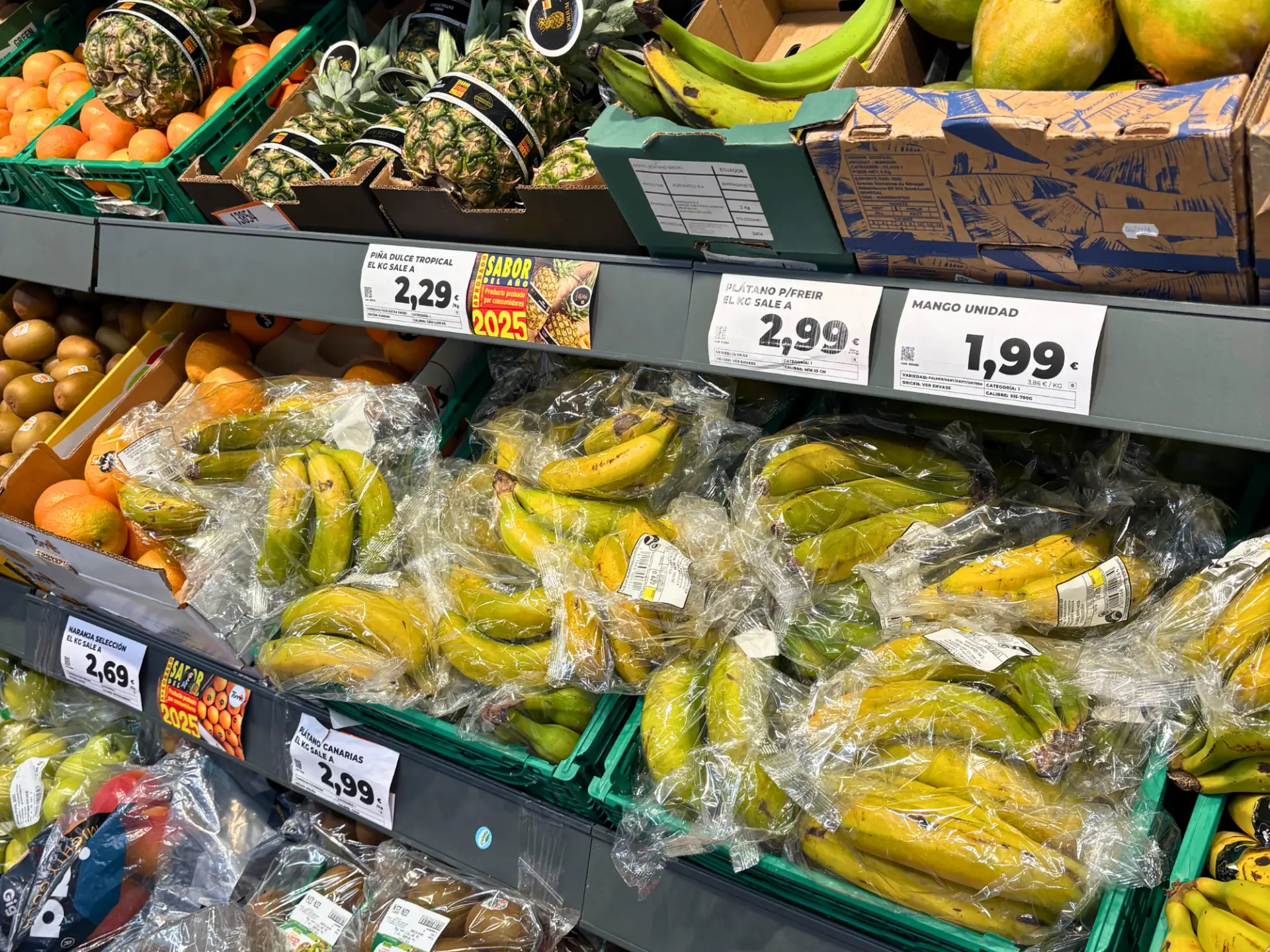Wondering what groceries really cost in Spain? One of the questions I asked myself before moving to Madrid was how much I would need to budget for everyday essentials—like milk, produce, and eggs—and how it compares to grocery prices back home in the U.S. Now that I’ve spent months grocery shopping in Spain, I’ve put together a real-life comparison of grocery prices in Spain vs. the U.S.
Whether you’re planning to move abroad, budgeting for expat life, or just curious about the cost of food in Madrid, this guide breaks down exactly what we spend—and where we save.
Spoiler: the good things in life like wine, olive oil, and bread are way cheaper (and better) over here!
Grocery Shopping in Spain: What to Expect
In Spain you’ll find a mix of different grocery stores to shop from. The biggest and most common grocery chains are:
- Mercadona (nice, slightly more expensive)
- Carrefour (cheap and convenient)
- Lidl (budget store)
- Día (similar to Carrefour)
Usually you’ll find 2-3 of these different brands in each neighborhood depending on where you live, giving you a few different options to choose from.
Each neighborhood usually has a local market as well, with vendors selling produce, meats, and sometimes even specialty or packaged goods. I would always encourage you to shop local whenever you can to help support your community!
For the purposes of this list, I’m comparing Spanish prices that I see at my local Día, compared against the prices my friends and family see at Kroger in Indiana. In terms of pricing and quality, Día and Kroger are pretty equal in terms of offering.
Example Grocery List with Prices – Spain vs. U.S.
| Item | Price in Spain (EUR) | Price in U.S. (USD) |
|---|---|---|
| Milk (1L) | €1.25 | $1.79 |
| Oat Milk (1L) | €0.99 | $5.39 |
| Eggs (12) | €2.60 | $3.25 |
| Bread (bar) | €0.89 | $2.19 |
| Olive Oil (1L) | €5.00 | $8.89 |
| Chicken (1kg) | €6.99 | $6.00 |
| Peaches (6 pieces) | €2.49 | $7.50 |
| Mango (2 pieces) | €3.98 | $2.38 |
| Pack of lunch meat | €2.35 | $4.00 |
| Sugar (1Kg) | €1.19 | $2.5o |
| Coffee (ground, 250g) | €2.75 | $5.69 |
| Pack of domestic beer (12 bottles) | €7.99 | $14.52 |
| Bottle of wine (mid range) | €5.00 | $15 |
| Toilet paper (12 rolls) | €3.99 | $5.00 |
Keep in mind that in Madrid, since there’s usually a grocery store on your street or within walking distance, you would rarely buy a weeks worth of products at once. Instead when shopping in Spain, people tend to buy a few items that they’ll use that same day.











Where You’ll Save (and Where You Might Spend More)
Things I notice the most that are cheaper in Spain include household goods like toilet paper and paper towels, as well as wine and olive oil, where you get a much better quality for a way smaller price. Even items like oat or soy milk are way more affordable than in the U.S.
The downside is that the grocery stores don’t contain many international foods, and if you want something specialty like true Mexican tortillas or packaged goods, those are much more expensive at the international grocery store. You’ll also see higher prices on some produce items when they’re out of season or imported — but I think that’s pretty consistent across both countries.
The last thing to keep in mind is the quantities — in Spain, you won’t find the “value packs” or huge quantity of items that you see in the U.S. This is why it’s important to compare items and prices based on measurement, because the way goods are packaged varies dramatically between the U.S. and Spain.
Monthly Grocery Budget in Spain
My husband and I usually spend somewhere around €200-250 per month, and I would say that’s on the higher end. We cook about half of the time and prioritize creating healthy but fun meals, which sometimes use a lot of different ingredients.
Compared to the U.S., it was normal for us to spend up to $400-450 per month, but keep in mind that some of this was due to the “value pack”/Costco approach to household staples, which while they do last a long time, this approach tends to add a lot to your monthly grocery bill.
When all is said and done, we tend to eat much healthier meals for much less money than we ever did in the U.S. I’ve found that healthier food is more accessible and more affordable than it was in the U.S.
6 Things I Wish I Knew About Buying Groceries in Spain
- Italian sausage doesn’t exist. Heartbreaking, I know. Instead, I usually buy plain sausage and season it myself at home. It’s a lot more work, but still tastes pretty close to what I was used to in the U.S.
- Ultra processed foods and snacks tend to be more expensive in Spain, and produce and meat tend to be cheaper. This is the reverse of the U.S., where chips and unhealthy snacks are typically the cheapest items at the grocery store.
- There are more American snack products than you’d realize, but they don’t always taste the same (like sour skittles). Guess I didn’t need to emergency pack a family size bag of Reese’s cups.
- Your options at the grocery store will be more limited based on the season/smaller store sizes. You often have to visit bigger supermarkets or multiple locations if you want specialty items.
- You may have to shop in multiple different stores — when we have the time, we prefer to buy meat at the local market, get bread from the local bakery, and get produce from the frutería in our neighborhood.
- Almost every grocery store has a machine for you to bottle your own fresh squeezed orange juice. It is pure magic!

Final Thoughts: Is Grocery Shopping in Spain More Affordable?
Living in Madrid has completely changed the way we shop for food—and for the better. Our monthly grocery bill is lower than what we used to spend in the U.S., and we’re eating fresher, healthier meals with ingredients that are locally sourced and more affordable. While some specialty or international products can cost more, everyday essentials like olive oil, produce, bread, and even plant-based milk are significantly cheaper in Spain.
Shopping in smaller quantities, visiting multiple stores for different items, and adjusting to seasonal availability have all become part of our weekly rhythm—and honestly, it’s made us more intentional about what we buy and eat.
If you’re moving to Spain or just curious about the cost of living abroad, I hope this gives you a clearer picture of what to expect when it comes to grocery shopping in Spain. And fret not — you can still get your Reese’s cups and Kitkat bars here in Spain.
Let me know what you think in the comments!
Want more from Everyday Abroad? Subscribe to our newsletter to get the latest moving abroad tips, travel guides, and freebies straight to your inbox!




